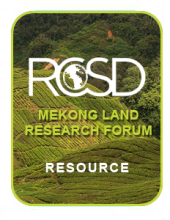Land Library
Bienvenido a la biblioteca de Land Portal. Explora nuestra amplia colección de recursos de acceso abierto (más de 74.000), que incluye informes, artículos de revistas científicas, trabajos de investigación, publicaciones revisadas por pares, documentos jurídicos, vídeos y mucho más.
/ library resources
Showing items 1 through 9 of 56.A USAID country profile of Myanmar. The profile includes indicators on population, land, fresh water, trees and forests and minerals, with discussion for each covering resource quantity, quality and use, legal framework, tenure types, administration, rights and conflicts and donor interventions.
A legal review of Myanmar's 'Farmland Law' and 'Vacant, Fallow and Virgin Lands Management Law', published by Food Security Working Group’s Land Core Group in November 2012
An overview of the Asian Development Bank's Economic Cooperation program for the Greater Mekong Subregion, published in 2012.
Rural areas in Cambodia have been the target of large-scale land acquisitions since the late 1990s. As of March 2012, economic land concessions in Cambodia covered more than 2 million hectares, equivalent to over half of the country’s arable land.
Increased global demand for land underscores the need for well-designed, country-level land policies to protect long-held rights, facilitate land access, and address constraints to growth. However, reforms are often technically complex, politically sensitive, and time consuming.
ABSTRACTED FROM THE PROGRAM DESCRIPTION: In recent years, various actors, from big foreign and domestic corporate business and finance to governments, have initiated a large-scale worldwide enclosure of agricultural lands, mostly in the Global South but also elsewhere.
ABSTRACTED FROM WEB INTRODUCTION AND EXECUTIVE SUMMARY: In order to inform Myanmar’s first multi-stakeholder national dialogue workshop on land tenure and user rights (held November 24th & 25th, 2012), Forest Trend’s Senior Law & Policy Advisor Rob Oberndorf was asked to conduct an in-dep
Through LMAP, and subsequent LASSP, Cambodia has made impressive progress in building a functioning cadastral system over the last ten years.
This paper uses four years of panel data on 793 households collected during 2001–11 to measure chronic poverty in rural Cambodia and to identify its key determinants.


